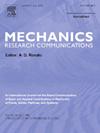Comparative analysis of beam responses via Hencky and fractional models under different mass distributions
IF 2.3
4区 工程技术
Q3 MECHANICS
引用次数: 0
Abstract
This study presents a comparative analysis of the mechanical responses of beams modeled using Hencky and fractional approaches under various mass distribution conditions. The beam models considered in this study are composed of rigid segments connected by rotational springs, with three distinct mass distribution schemes analyzed: masses concentrated at the joints, masses located at the midpoints of each rigid part, and masses uniformly distributed along each segment. The developed model converges to the Euler–Bernoulli beam theory in the continuum limit, as the number of rigid segments tends to infinity. Closed-form expressions for natural frequencies are derived for simply supported boundary conditions. To approximate the dynamic response of these discrete models and capture their scale-dependent effects, corresponding nonlocal fractional continuum models are formulated using the symmetric Caputo derivative. These models enable precise fractional parameter calibration based on discrete systems’ dispersion relations. The analysis reveals a strong influence of the mass distribution on the dynamic behavior, with stiffening or softening effects emerging depending on the mass arrangement. The proposed fractional framework successfully replicates the dispersion characteristics of each discrete Hencky model and confirms that the accurate selection of fractional derivative parameters effectively models the vibrational behavior of microstructured beams.
采用Hencky模型和分数阶模型对不同质量分布下的梁响应进行对比分析
本文对不同质量分布条件下采用Hencky法和分数法建模的梁的力学响应进行了比较分析。本文所考虑的梁模型由由旋转弹簧连接的刚性段组成,分析了三种不同的质量分布方案:质量集中在节点处,质量位于每个刚性部分的中点,质量沿每个刚性段均匀分布。该模型在连续体极限下收敛于欧拉-伯努利梁理论,刚性段数趋于无穷大。导出了简支边界条件下固有频率的封闭表达式。为了逼近这些离散模型的动态响应并捕捉它们的尺度依赖效应,利用对称Caputo导数建立了相应的非局部分数连续体模型。这些模型能够基于离散系统的色散关系进行精确的分数参数校准。分析表明,质量分布对动态性能有很强的影响,随着质量分布的不同,会出现硬化或软化效应。所提出的分数阶框架成功地复制了每个离散Hencky模型的色散特性,并证实了分数阶导数参数的准确选择有效地模拟了微结构梁的振动行为。
本文章由计算机程序翻译,如有差异,请以英文原文为准。
求助全文
约1分钟内获得全文
求助全文
来源期刊
CiteScore
4.10
自引率
4.20%
发文量
114
审稿时长
9 months
期刊介绍:
Mechanics Research Communications publishes, as rapidly as possible, peer-reviewed manuscripts of high standards but restricted length. It aims to provide:
• a fast means of communication
• an exchange of ideas among workers in mechanics
• an effective method of bringing new results quickly to the public
• an informal vehicle for the discussion
• of ideas that may still be in the formative stages
The field of Mechanics will be understood to encompass the behavior of continua, fluids, solids, particles and their mixtures. Submissions must contain a strong, novel contribution to the field of mechanics, and ideally should be focused on current issues in the field involving theoretical, experimental and/or applied research, preferably within the broad expertise encompassed by the Board of Associate Editors. Deviations from these areas should be discussed in advance with the Editor-in-Chief.

 求助内容:
求助内容: 应助结果提醒方式:
应助结果提醒方式:


